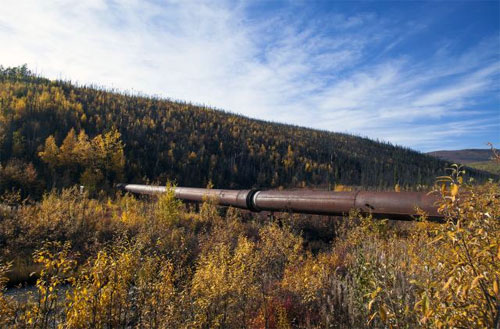
90-mile aqueduct still etched in Interior hillsBy NED ROZELL September 28, 2013
The 90-mile system of canal, pipeline and tunnel becomes harder to see with each passing day, but the engineering triumph once helped prevent Fairbanks from ghosting out. The 1920s-era aqueduct provided the water needed to float dredges the size of apartment complexes and power hydraulic giants that firehosed water at Tanana River valley hillsides, stripping them to bedrock. A water pipeline near U.S. Creek that makes up part of the Davidson Ditch, a 90-mile aqueduct from the upper Chatanika River to near Fairbanks. Workers finished the project in the late 1920s. It lasted until the late 1960s, when a flood damaged the containment dam.
The United States Smelting and Refining Company, a Maine corporation with headquarters in Boston, operated the Fairbanks Exploration Company, which was devoted to removing gold from the streams of the Tanana Valley. At the urging of a civil engineer named James Davidson, leaders of the company decided to build a water-moving system from the upper Chatanika River to Fairbanks. The execution of the project from 1924 to 1926 probably swayed the bulk of the Fairbanks population to stay here, wrote Catherine Williams and Sarah McGowan in their research document The Davidson Ditch, which they produced for Northern Land Use Research, Inc. By 1926, the “FE Company” employed about 80 percent of the people in Fairbanks. Many of the 1,372 on the payroll worked on the Davidson Ditch. James Davidson, who saw the potential for and designed the aqueduct, was a rarity among gold-rushers who climbed Chilkoot Pass and descended into the Yukon in 1898. When he arrived in the far north he already had 25 years of engineering and mining experience. After moving to Nome on July 4, 1899, Davidson soon created a map of the Nome Peninsula, discovered a spring still used for drinking water there, and designed what became known as the Miocene Ditch to move large volumes of water. After accomplishing so much in Nome, Davidson traveled Alaska looking for mining opportunities. When he visited the Fairbanks district, which in the early 1920s was becoming less remote because of an Alaska Railroad extension from Seward, Davidson saw the potential for a longer version of Nome’s 54-mile Miocene Ditch. He convinced FE Company executives to invest millions in 83.3 miles of open waterway as wide as a single-lane highway, 6.1 miles of pipeline to shortcut narrow valleys and a tunnel through a hillside almost one mile long. To dig the canal-like portions of the ditch, workers used power shovels, three fueled by diesel and three by steam. Officials with the Alaska Engineering Commission brought the steam shovels to Alaska after others had used them to dig the Panama Canal. Men with shovels did much of the work, including the leveling of the ditch. When the Davidson Ditch was complete in 1928, just after James Davidson died at 75, the system moved water using no fossil fuel. Gravity carried the water slowly (with an elevation drop of just two feet per mile) to gates where miners could release it on demand. Water from the project powered hydraulic giants with enough pressure to strip the landscape 200 feet away from where miners pointed the nozzles. “Only by moving millions of cubic yards of the muck overlying gold-bearing gravels . . . could the low-grade placer gold deposits be mined profitably,” Williams and McGowan wrote. The FE Company used and maintained the aqueduct until the early 1950s. By the mid-1960s, no more FE Company dredges were working, but a businessman named Arnold Hanson found a new use for the Davidson Ditch. He built a power plant and started the Chatanika Power Company in 1959. Hanson provided electricity to the Golden Valley Electric Association until the same rains that flooded Fairbanks in August 1967 wrecked the ditch’s containment dam.
Since the late 1970s, the University of Alaska Fairbanks' Geophysical Institute has provided this column free in cooperation with the UAF research community. E-mail your news &
photos to editor@sitnews.us
|
||
